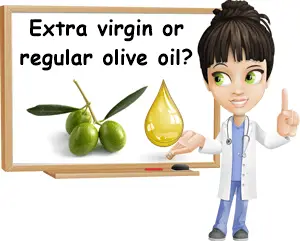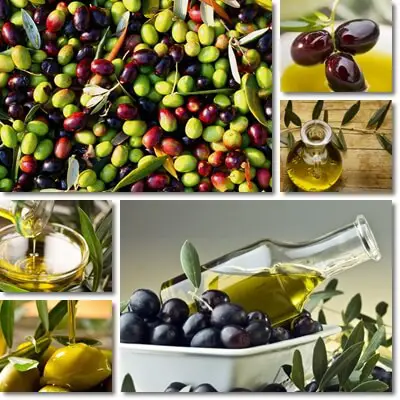Between regular olive oil and extravirgin, the latter is definitely the healthier option. In fact, extravirgin olive oil is the healthiest of all the different types of olive oil and the best suited for both cooking and at-home cosmetic use for hair and skin care.
But what makes extravirgin olive oil healthier than regular? There are actually significant differences between the different grades of olive oil, from extraction method, degree of processing to organoleptic characteristics, nutritional value, antioxidant content and even edibility, hence the grades determining the uses, properties and health benefits of the different types of olive oil.
Find out below how regular and extravirgin olive oil compare and why one is incomparably healthier than the other.
What is extravirgin olive oil?
Extravirgin olive oil is the healthiest type of all the different olive oils. It is cold-pressed, which means no heat was used for its extraction. It’s minimally processed, meaning the fruits are pressed for oil, the oil separated from the fruit pulp and water, then the impurities filtered out to get a more visually appealing, uniform-looking oil with a longer shelf life.
It is first-press, meaning that the oil is extracted using a press, and, in certain instances, that the olives were used just that one time for oil. It is high-grade, the highest-grade olive oil in fact, both for all of the reasons above, and because of its superior flavor profile and nutrition. Extravirgin olive oil has a free acidity content of up to 0.8%, and the olives used are superior in quality, meaning without spots, blemishes, rot, mold, insect damage or any defects, aspects which contribute to the resulting oil’s appearance, taste, odor, shelf life and overall quality.

What is regular olive oil?
Simply known as olive oil by its label, regular olive oil is olive oil that is not extravirgin or virgin. It’s sometimes also called pure olive oil because it’s all olive (not blended with other edible oils). But there’s not just one kind. Regular olive oil can be 100% refined olive oil, or a blend of mostly refined and smaller amounts of virgin or, more rarely, extravirgin olive oil. It’s sometimes also classified according to the degree of refining it underwent: there’s Pure and Classic, and then there’s the usually more refined options Light and Extra-Light olive oils.
Regular olive oil is lower-grade than extravirgin. It is produced from virgin or defective virgin olive oil, or from lampante, which is an inedible type of olive oil. While it’s all made from olives, regular olive oil is extracted using heat and solvents and has less flavor and fewer beneficial properties.
The refining process typically includes bleaching and deodorizing the oil to remove color, flavor and odor, as well as make the oil more heat-stable, thus more suitable for cooking.
But because refining removes the characteristics of olive oil that make it unique and sellable, sometimes producers add small amounts of virgin or, more rarely, extravirgin olive oil to restore some of the color and flavor. So regular olive oil is, in fact, either 100% refined olive oil, or mostly refined and some virgin or, more rarely, extravirgin olive oil.
See all 7 types of olive oil by quality and find out what they are, how to use them and what to use them for.
What is extravirgin olive oil blend?
As the name suggests, it’s a blend with extravirgin olive oil. Now, that doesn’t mean it’s more extravirgin olive oil than lesser grades. In fact, it means quite the opposite: lower-grade olive oil with some extravirgin oil to impress. In other words, an extravirgin olive oil blend is what is typically known as regular olive oil, or simply olive oil. And it will likely contain refined olive oil in greater amounts than extravirgin.
There’s usually very little extravirgin, if any, in blends claiming to have extravirgin. Extravirgin olive oil doesn’t need any publicity – it’s already known as the healthiest type of olive oil, so the best for health.
But lesser-grade types do need the marketing, hence the reason they’re blended with higher-grade types such as extravirgin. So if you’re looking at an extravirgin olive oil blend, read the label to find out exactly what that blend is.

Can olive oil replace extravirgin in cooking?
It can, but only in certain instances. Extravirgin olive oil itself can be used fresh, in food or for hair care or skin care, or for cooking. Anything up to deep frying is okay; since the extravirgin grade has a smoke point of 190-215 degrees Celsius, it’s best used for light cooking only. Regular olive oil can replace extravirgin in cooking, including deep frying, but only if it’s 100% refined (not a blend of refined and virgin or extra virgin).
In fact, it’s deemed better for use in cooking than extravirgin. While its smoke point is about the same, that is, 210 degrees Celsius, the fact that it’s refined means that it’s more heat stable and should not form toxic by-products that are harmful for health, even in high-heat conditions. Of course, using regular olive oil for deep frying and similar high-heat cooking is not actually healthy, just a little healthier than using extravirgin. It’s deep frying after all.
Also read about the difference between extravirgin olive oil vs olive oil.
Conclusion
Is regular olive oil is as healthy as extravirgin? Answer: it’s not. Extravirgin olive oil is cold-extracted, by crushing and pressing fresh olives of the utmost quality, and minimally processed so that the oil maintains its natural properties, nutritional value and unaltered antioxidant profile and fatty acids composition. That’s why it’s healthy. Regular olive oil is definitely not as healthy as extravirgin, mainly because it’s refined, which means it’s produced using heat and solvents. Throughout the entire production process, steps are taken to remove color, flavor and odor, which means removing healthful compounds that give color, flavor and odor to the oil, but which also represent a source of health benefits. The only instance when regular olive oil is as healthy as extravirgin is in cooking, more exactly, cooking at high temperatures. Refined oils in general are more heat-stable so, if your regular olive oil is 100% refined, it might be better to use it for deep frying and reserve the extravirgin oil for fresh use.
